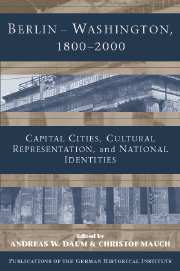Book contents
- Frontmatter
- PART I CITIES AS CAPITALS ON A GLOBAL SCALE
- PART II THE CAPITAL IN THE NATION
- 2 Siting Federal Capitals: The American and German Debates
- 3 Written Capitals and Capital Topography: Berlin and Washington in Travel Literature
- 4 Prime Meridians, National Time, and the Symbolic Authority of Capitals in the Nineteenth Century
- 5 Washington and Berlin: National Capitals in a Networked World
- PART III ARCHITECTURE, MEMORY, SPACE
- PART IV POLITICAL POWER AND CAPITAL FUNCTIONS
- Index
2 - Siting Federal Capitals: The American and German Debates
Published online by Cambridge University Press: 05 January 2013
- Frontmatter
- PART I CITIES AS CAPITALS ON A GLOBAL SCALE
- PART II THE CAPITAL IN THE NATION
- 2 Siting Federal Capitals: The American and German Debates
- 3 Written Capitals and Capital Topography: Berlin and Washington in Travel Literature
- 4 Prime Meridians, National Time, and the Symbolic Authority of Capitals in the Nineteenth Century
- 5 Washington and Berlin: National Capitals in a Networked World
- PART III ARCHITECTURE, MEMORY, SPACE
- PART IV POLITICAL POWER AND CAPITAL FUNCTIONS
- Index
Summary
The journal Foreign Affairs marked the fiftieth anniversary of the Berlin Airlift with a series of articles on the city's past and future. In one, Christoph Bertram argued that while national politics no longer requires a capital, national political culture does. In another article, Gordon A. Craig observed that the prestige of a great nation depends on how it promotes the arts and sciences and attends to its capital. By “capital,” both Bertram and Craig mean much more than just “seat of government,” a place limited to the governing function. A capital is a seat not only of government, but also of culture and business, and even of the social elite. A capital is a multidimensional reflection of national identity and a repository of a nation's memory. While a seat of government can evolve into a capital - as the case of Washington demonstrates - the distinction can remain quite clear. The Netherlands' seat of government is The Hague but its capital is bustling, commercial Amsterdam, the national cultural center. Canberra, Ottawa, New Delhi, and Brasilia are only seats of government; important political decisions are made in these cities, and they receive little public attention except for such decisions. London and Paris, on the other hand, are capitals in the true sense of the word. For several centuries, they have been hubs of urban, political, commercial, and cultural development. What do the histories of Berlin and Washington tell us about this distinction?
- Type
- Chapter
- Information
- Berlin - Washington, 1800–2000Capital Cities, Cultural Representation, and National Identities, pp. 31 - 50Publisher: Cambridge University PressPrint publication year: 2005
- 4
- Cited by

